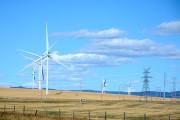Alberta’s power grid is essentially an electricity island, isolated from its neighbours except for three small connections. Adding more capacity in cross-border transmission, otherwise known as interties, would dramatically increase the cost-effectiveness, reliability and resilience of the power grid. Extensive interties between Alberta and its neighbouring provinces and territories would also strengthen inter-provincial trade – key in this new era of market protectionism between Canada and our largest trading partner, the United States.
Staying connected
Staying connected with our neighbours is vital to balancing our grid. Currently, Alberta’s three very small interties link us to B.C., Saskatchewan and Montana. These weak interconnections limit our ability to develop the fastest growing and most cost-effective source of new electricity: wind and solar. Alberta only generates 17% of its power from wind and solar, but this could grow if we had the capacity to send excess power to neighbours when Albertans’ needs are met and bring it back when needed.
Increasingly, extreme weather combined with Alberta’s aging transmission infrastructure creates a vulnerable electricity system. Already, we have seen more grid alerts – partly due to unplanned outages at gas plants and higher than anticipated demand caused by extreme weather events. But by upgrading and building more interties, our grid can be more flexible, balancing generation and demand across a wider region and enabling commercial access to the vast storage potential of B.C.’s hydro resources. Sharing electricity westward when it is sunny and windy in Alberta lets hydro reservoirs fill up so they can return the favour to the prairies when the weather is less cooperative.
Increasing energy exports
Increased interties would not only strengthen our grid, but would also help increase provincial energy exports, setting Alberta up to gain more as we become a net exporter of clean energy. Our research shows that with its growing wind and solar fleet, Alberta could expand electricity exports. However, even while power demand in the province grows, new restrictions on the wind and solar sector and ongoing uncertainty in the renewable energy sector from the government’s 2023 moratorium are stifling investment in a previously booming industry.
Former Prime Minister Jean Chrétien has correctly pointed out that trade between provinces is often harder than with other countries. In this new era of trade conflict with the United States, increased interprovincial trade is an obvious economic growth and security opportunity. Alberta only has very limited interties, with capacities of 0.8 GW with B.C. and 0.2 GW with Saskatchewan. Yet Canada is replete with examples of grids made stronger and more economically resilient with extensive interties. Ontario and Quebec have around 3 GW of total intertie connection capacity between them. Quebec can also import 5.4 GW of power from their recent contract renegotiation with Newfoundland and Labrador, greatly improving trade dynamics between the two provinces and powering up clean energy investments in mining and other industries. The deal also includes a commitment to increase their intertie capacity in the future.
Building a clear policy framework
By increasing our interties, we can enhance the resilience of our grid, create more economic opportunities, boost affordability and transition to cleaner sources of power. But to do this, we need a clear policy framework that helps, not hinders, transmission expansion. It should include things like:
- simplifying regulatory processes to reduce delays in building new transmission lines
- incentivizing private investment through provincial and federal investment in transmission infrastructure
- proactively engaging with communities to address concerns and boost support for transmission projects
- strengthening cooperation on electricity system planning with neighbouring provinces.
We also need provinces to discuss the benefits they would receive from new interties so project costs can be shared appropriately. Trust and fairness are key. Projects of this scale need premiers to get together and set the terms.
With the right policies in place to enable interties, Alberta can lead in clean energy investment, drive economic growth and build a secure, resilient, and affordable electricity system – the backbone of the province’s future prosperity.









